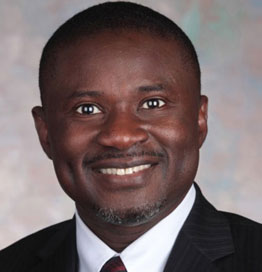
As RAPID + TCT celebrates our 30th year, we wanted to hear from past attendees who have joined us year after year, to find out what makes them keep coming back. To them, RAPID + TCT is like coming home.
This article will focus on Sheku Kamara. Kamara is the dean of applied research at the Milwaukee School of Engineering (MSOE) and has attended 17 iterations of RAPID + TCT.
Kamara oversees the activities of the Applied Technology Center™ (ATC), which uses MSOE faculty, staff and student expertise to solve technological problems confronting business and industry. He has been involved with additive manufacturing since 1996 and was director of the Rapid Prototyping Consortium at MSOE. Kamara received a Rapid Technologies and Additive Manufacturing (RTAM) master level certificate from SME, and was named a Laser Sintering Distinguished INnovator Operator (DINO) by the Additive Manufacturing Users Group (AMUG) for his contributions to the technology and industry. Kamara has served as a technical advisor to the RAPID conference since 2004 and is a past chair of the Additive Manufacturing Users Group (AMUG).
Why did you get started in rapid prototyping?
As a graduate student, I was introduced to the Rapid Prototyping Center (RPC) at Milwaukee School of Engineering in 1996. I was fascinated by the technology and was initially hired as a graduate research assistant supporting the technical aspect of the SLA 250/50, eventually supporting the FDM1650, Helisys LOM-2030 and SLS-2000.
What is your unique story?
In the mid-‘90s, most service bureaus and companies focused on a specific brand of rapid prototyping machine. At MSOE, I was fortunate to be officially trained at 3D Systems for the SLA, at DTM for the SLS-2000, at Stratasys for FDM, and in-house for the Helisys LOM-2000. I am one of a few folks with that background in the industry.
How has attending RAPID + TCT impacted your business and/or career? (For example, is there a specific technology you found, purchase you made, new person you met, etc. that made a difference?)
Before attending RAPID, I attended the stereolithography (SLA), selective laser sintering (SLS) and fused deposition modeling (FDM) users groups, which were technology-specific. RAPID provided an opportunity to experience different rapid prototyping technologies with technical presentations that were useful for our consortium members. I also had to attend to take the SME master level rapid prototyping exam, which was only available at the conference. The combination of 3D scanning, imaging and software also created an opportunity for me to learn — and eventually introduce and implement — scanning at MSOE’s RPC lab. It was the only conference I attended where inventors and leaders in the industry met. It provided an opportunity to network with the best and brightest in the industry — connections that continue to the present day. For North America, new rapid prototyping technology and materials were routinely announced at the conference, creating an opportunity to stay at the forefront of the technology.
Why do you come to RAPID + TCT?
To stay abreast of the additive manufacturing and 3D scanning technology, strengthen current relationships, develop new ones and mentor newbies. It’s part of my annual additive manufacturing education — can’t miss it.
Thank you so much for sharing your story with us, Sheku! We appreciate your loyalty to RAPID + TCT.
